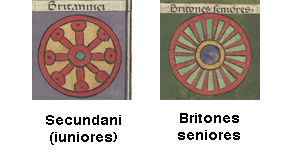
This page created 11 May 2014, and last modified: 2 August 2015 (Maier reference numbers added)

In the eastern half of the empire, the sole unit of legiones palatina under the command of the Magister Militum per Illyricum is listed (21.6 in Ingo Maier's numbering scheme) as the Britones seniores. Its shield pattern (19#2) as shown in various manuscripts, under the matching label (19.a) Britones seniores, is as below:

The pattern features a blue boss (but white in M, W) ringed with a narrow yellow band (red in W) that is itself surrounded by a red band in B. The ground is green (but faded to white in M and yellow in W), with a red rim, and 16 (F), 18 (P, W), 19 (O), or 20 (M) red rays emanate from the centre. Due to these spokes, the pattern therefore looks somewhat like those of the Lanciarii seniores (9.17) and Lanciarii iuniores (12.21), but without their broad blue rims.
The Britones seniores is the only palatine legion that is not part of a set of six. In the west, the Magister Peditum's Italian command has six legiones palatina, as does the Magister Equitum's Gallic command. And in the east, the command of the Magister Militum Praesentalis I has six legiones palatina, as does that of the Magister Militum Praesentalis II. The Britones seniores breaks the symmetrical arrangement.
The name Britones clearly indicates a British origin for the unit. Of the three legions associated with Britain, Legiones II, VI, and XX, only the first, Legio II Augusta, seems to have been called "the Britones" in the Notitia, at least, since although a detachment of the unit is listed under the Comes litoris Saxonici per Britanniam as the Legio secunda Augusta (132.8), this appears to be the same unit as not only the Secundani iuniores (101/5.208) under the Comes Britanniarum, but also the Secundani Britones in the Magister Equitum's Gallic command (102/5.1326) and the Legio secunda Britannica siue Secundani (98/9.115) of the Magister Peditum's infantry list. Putting these names together one can easily imagine the existence of a putative Britones iuniores derived from Legio II Augusta to counterpart the Britones seniores under the Magister Militum per Illyricum. This is reinforced by comparing the shield patterns of the Britones seniores and Legio II Britannica. They are not closely similar, as the comparison below, using the appropriate Parisian manuscript pictures, shows, but they do share a radiating wheel-like motif in red.

If the Britones seniores was not derived from Legio II Augusta, then the next most likely candidate is probably Legio VI Victrix, since while the Sixth was not called "Britones", it, like II Augusta, did carry the title "Britannica", in the form of Legio VI Victrix Pia Fidelis Britannica, as a result of heavy fighting in Scotland in the early 3rd century. And finally, Legio XX Valeria Victrix, while not having seemingly been called something like "Britones" or "Britannica", seems to have left no record of its existence in Britain during the 4th century. It may be it was removed from Britain in toto, and perhaps part of it later became the Britones seniores. See also further speculations under the Legio secunda Flavia Gemina (18.19).

Return to the Notitia alphabetical unit list page.
Return to my Notitia index page.